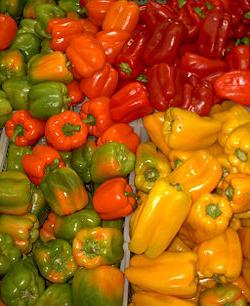The disease of Bulgarian pepper is the result of improper care
Bulgarian pepper or, as it is also called,sweet is a thermophilic plant. It comes from Africa and is accustomed to sunlight, warm breeze and low humidity. Therefore, in our climatic conditions, this or that disease of Bulgarian pepper or various pests may appear. Today we will tell you about what diseases this plant is exposed to, what insects can damage a crop, how not to admit it.
Sweet pepper diseases
Like all cultivated plants, diseasesBulgarian pepper (photo attached) are divided into viral, bacterial and fungal. The most common on this plant of the Solanaceae family can be found signs of the following diseases:
- with white rot, the upper part of the plant withers, and the bottom of the stem decays;
- For gray rot, stains on fruits of light green color and brown dots on them are characteristic;
- the base of the fruit, covered with brown spots - is a disease of Bulgarian pepper called brown rot;
- tobacco mosaic (leaves with dark and light green stripes);
- fusarium wilt, in which yellowed leaves and shoots wilt;
- black leg - a disease characteristic of peppers grown in a greenhouse, manifested by the blackening of the stem at the base, as a result, the plant dies;
- Fusarium - a disease in which the leaves drop;
- late blight - solid dark spots on the fruit, more often at their ends;
- spotted wilting - leaves with a purple hue and brown spots, the fruits are ringed with rims from green to yellow;
- root rot - this disease can appear in both seedlings and in an adult plant.
How to treat Bulgarian pepper disease?
All these ailments appear due to increasedhumidity or due to improper care. Treated by drying the soil, loosening and sprinkling with wood ash. It is recommended to remove the affected bushes and burn them, in order to prevent infection of other plants. If the disease has only begun to appear, the pepper is sprayed with fungicides or "Fundazol".
Pest of pepper
Most often this plant is attacked by the following insects:
Aphids that appear on the leaves, and then spread to the whole plant. This insect drinks all the juices, and as a result, the pepper dies.
The tick is arachnoid. It acts the same way as the aphids, but it leaves a characteristic web.
Naked slugs that damage the fruit. As a result, they decay and become unsuitable.
To control all insects, spray the plant with "Carbophos" or "Keltan".
Care instructions
All diseases and pests of Bulgarian pepper are in most cases a consequence of inaccuracies in care. You need to know the following:
- pour the pepper no more often than twice a week with warm water;
- for the whole summer they fertilize up to five times with mullein, bird droppings, urea, or complex mineral fertilizers;
- pinch the tops of the plant and remove excess stepsons;
- regularly loosen the soil and plant the plant;
- weed plants are removed;
- before planting it is recommended to disinfect seeds and soil.
And, of course, under favorable weather conditions, when it's not too hot and not cold, no Bulgarian pepper disease will spoil your harvest.






